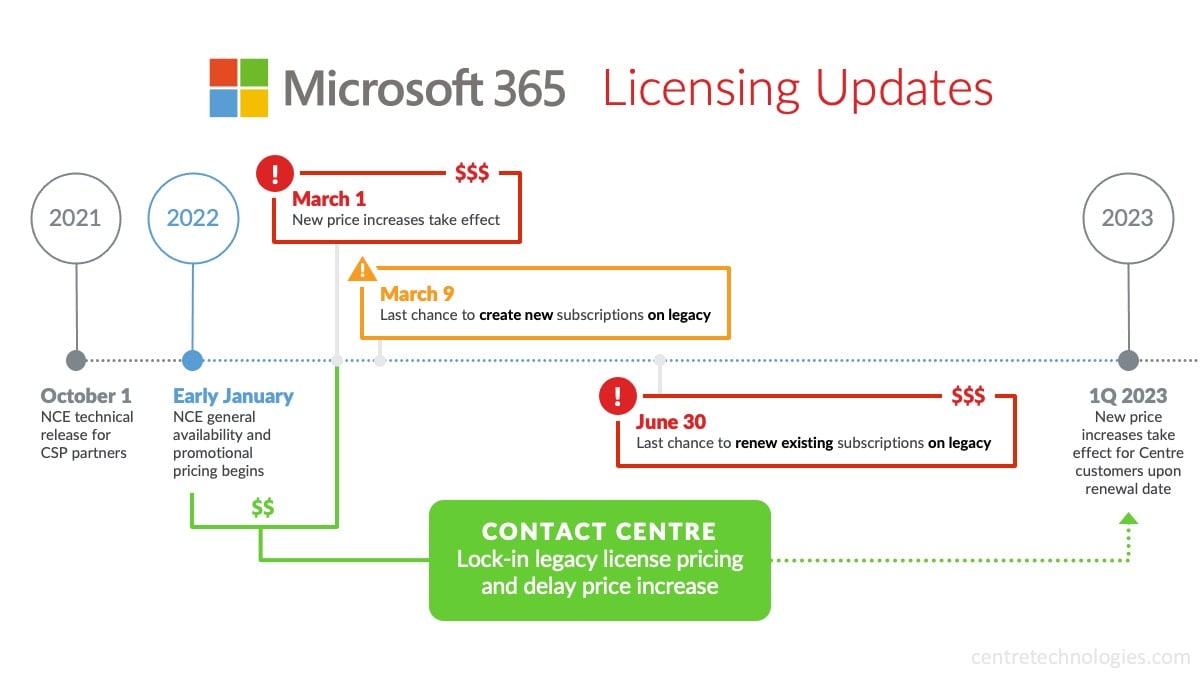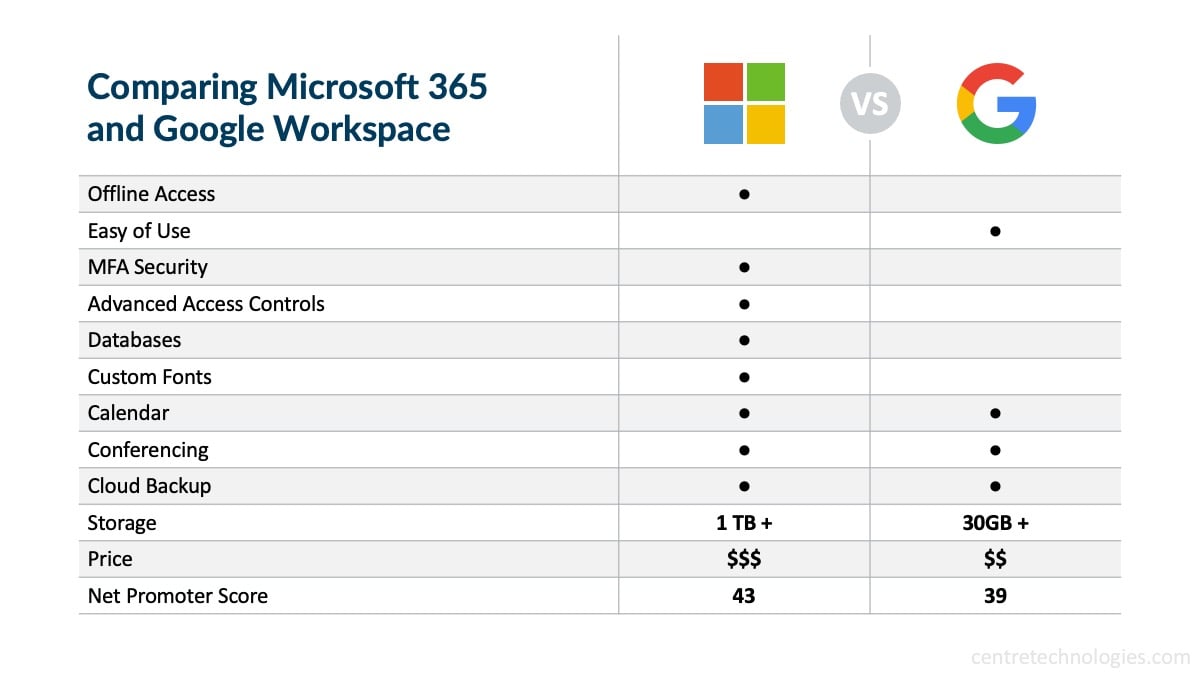Microsoft 365 vs. Google Workspace Licensing Model Changes
Both Office 365 (now Microsoft 365) and G-Suite (now Google Workspace) are undergoing important changes. These changes are fairly similar, as both have to do with altering subscription and licensing for businesses. Companies aren't the happiest with the price increase imposed by these alterations. That said, evaluating both the pros and the cons within each can help business leaders decide how to move forward. Here's why cloud costs are increasing, differences between Microsoft 365 and Google Workspace licenses, and the pros and cons of monthly and annual subscriptions.
Are Cloud Costs Increasing and why?
According to Gartner, cloud costs will increase at a rate of 21.7%, reaching $482 billion in 2022. Along with these increases, IT budgets are expected to grow by 31% in North America. More than one third of the reason for this increase is due to COVID, as more businesses are looking to utilize technology to continue operating. Other reasons include updates to outdated cloud infrastructure that are needed to support increased demand of cloud services, increased security concerns, and business revenue increases.
Two of the most notable and recent displays of increasing cloud costs are the alterations made in Microsoft 365 and Google Workspace licensing models and pricing.
Overview of Microsoft 365 and Google Workspace Licenses
While there is a price increase to both Google Workspace and Microsoft 365, not all users will be feel impacted. Depending on how the licensing is purchased, some businesses may feel no financial difference at all. Starting March 1st, 2022, here's how license pricing for both Microsoft 365 and Office 365 are changing:
- Microsofts 365 Business Basic up to 20% more per user
- Microsofts 365 Business Premium up to 10% more per user
- Office 365 E1 up to 25% more per user
- Office 365 E3 up to 15% more per user
- Microsoft 365 E5 up to 13% more per user
- Office 365 E5 up to 8% more per user

"To get ahead of Microsoft 365 license changes, Centre is proactively working with customers to renew early to lock-in legacy pricing and reset the clock by 12 months."
Director of Strategic Revenue
Centre Technologies
Google Workspace announced its changes in October of 2020. Showcasing new pricing and licensing updates, Google its competitive edge. Googles price changes are listed below:
- Business Starter will be 20% more per user
- Business Standard will be 20% more per user
- Business Plus will be 6% more per user
- Enterprise once available to anyone will now only be available to businesses that need more than 300 licenses. The Enterprise package is available in three different types of licenses: Enterprise Essentials, Enterprise Standard, and Enterprise Plus.
Both Google and Microsoft present two payment plan options. Microsoft offers an annual subscription or a monthly subscription which costs about 25% more. Both require businesses to purchase a set amount of licenses that they cannot alter once purchased. This isn't the case with Google Workspace pricing.
Google offers a flexible plan in addition to an annual plan. The flexible plan allows businesses to pay only for the licenses that are being used. Businesses can add and remove licenses as neded every month. As for the annual option, businesses commit to purchasing the service for either a full year or for multiple years. The only time you can adjust the number of licenses you pay for however, is at the end of the paid for term. Whatever commitment you pay for at the beginning of the plan cannot be altered until the end of your plan.
What's the difference between buying cloud services Direct vs. CSP Reseller?
Whether or not the costs for businesses increases depends partially on whom they purchase their subscription from. They can either purchase directly or purchase from a CSP reseller. When purchasing from a CSP reseller, businesses can amplify their cloud experience a number of ways. CSP's can help with migrations, enable more flexible billing, and they can offer more readily available customer support.
"Ensuring our customers' M365 accounts and users are secure is our number one objective—limiting wasteful spending is number two. We're excited to deliver added visibility for our M365 customers that other CSPs simply aren't providing. In the end, it's a win-win."
Director of Enterprise Solutions
Centre Technologies
Why are Microsoft 365 and Google Workspace prices increasing?
When it comes to the reason behind these increasing cloud costs, all you have to do is tune into your local news station. There is an evident increase in security threats. According to a report done by PurpleSec, cybercrime is up 600% due to the COVID-19 pandemic. Cyber threatrs are only increasing and getting more dangerous.
Another reason for these increasing cloud costs is the cost of the cloud infrastructure itself. Companies like Microsoft and Google are paying not just to build these cloud infrastructures, but they are maintaining them as well. That comes at a certain cost to the company and therefore, as displayed in the latest price increase, to you.
Finally, more and more businesses are moving towards a cloud infrastructure. Due to the massive cost of hardware and lack of flexibility (especially since COVID), companies are opting for a cloud environment.
Pros and Cons of Monthly Subscriptions and Annual Agreements
The monthly subscription for both Microsoft 365 and Google Workspace cost more money, but allow businesses more flexibility and adaptability. Should businesses need to cancel some of their licences's, they can do so at will. The overall price will be more expensive than the annual agreement. For M365, this change will be effective on May 1st, with some grandfathered accounts enabled through June of 2022. As for Google, prices increased at the end of September in 2021.
With Annual Agreements, businesses can save money but are locked in for the set contract term. It doesn't matter how many licenses need to be purchased or discarded, businesses will pay the set amount they agree to no matter what.
Optimizing Microsoft 365 licensing matters now more than ever... By applying a hybrid model our customers get the cost savings from right-sizing annual licenses along with the added flexibility of a smart amount of monthly licenses.
Director of Enterprise Solutions
Centre Technologies
Managed Services providers like Centre Technologies ensure that businesses are paying for what they actually use rather than a large number of licenses within an annual commitment. By partnering with Centre Technologies, businesses can leverage a hybrid model of both right-sized annual agreements along with a smart amount of monthly subscriptions.
Google Workspace or Microsoft 365?
At the end of the day, Google specializes in search. Microsoft specializes in desktop applications. When it comes to productivity suites, these solutions are very similar. However, these very distinctions influence the different aspects of the experience that users get with each tool.

Ultimately, the decision is based on what is best for your business. If you need help making that decision, utilize our IT consultants here at Centre Technologies. We will help you decide what the best route to take for your business is and we will support your decision with our services.
Be a thought leader and share:
About the Author
Organizations partner with Centre to harness the benefits of cloud services and minimize the cost. Centre’s cloud services deliver comprehensive planning and dedicated support so customers can choose, navigate, and secure their cloud journey with confidence. With a focus on personalized solutions, Centre’s certified experts help customers achieve their business goals through public cloud services, private hosting options, or a combination of both. Learn more about Cloud Solutions »


